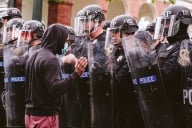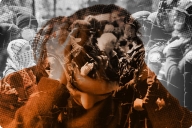You have /5 articles left.
Sign up for a free account or log in.

insta_photos/iStock/Getty Images Plus
Just two weeks into this academic year, Suzi Billington could tell that students whose career preparation efforts and experiences may have paused during the pandemic were playing catch-up. “Typically, early in the semester it’s a dead time for our career advisers, but not this year,” says Billington, director of the Carson Center for Student Success, which supports business college students at Washington State University. Seniors in particular are realizing the job search process has changed and they need to jump right in. Some are getting pressure from their families as well.
Read part one of this article, covering how future plans and career preparation approaches have shifted for students during the pandemic.
The latest Student Voice survey of 2,000 sophomores, juniors and seniors, conducted Aug. 18 to 25, asked about pandemic-era internships and other career preparation activities, plus how students feel about participating in activities this year and their upcoming job searches. Conducted by Inside Higher Ed and College Pulse with support from Kaplan, the survey reveals that:
- About one-third of students think they would have participated in more career service activities and events had they been held in person.
- Only 15 percent participated in a virtual internship during the pandemic -- and many parts of the experience were less than positive.
- The vast majority of students are worried about finding a meaningful first job after graduation (with 24 percent extremely worried).
Here are answers to five questions about what students experienced during the pandemic and what they expect and need from their colleges this semester and beyond.
Did Students Take Advantage of Career Center Offerings in the Past 18 Months?
Although six in 10 students agree their career centers have had sufficient services and supports during COVID, one in four haven’t used the services during this time (compared to 9 percent who did not use academic advising). Thirty-one percent believe they participated less because offerings were online.
Four-year students are almost twice as likely as two-year students (33 percent versus 18 percent) to report less involvement than they think they would have had if activities were in person. That’s in line with what Lakeisha Mathews is seeing at the University of Baltimore, a nonresidential institution whose students tend to have a mind-set similar to students at community colleges. “Students looking for a traditional college experience and traditional-age students seem to prefer in-person services,” says Mathews, director of the Career and Internships Center.
The general lack of participation during the pandemic is probably not reflective of career center attendance across the board, says Salil Pande, founder and CEO of VMock Inc., which offers an AI assistant that manages mundane tasks for career center offices. “Some [centers] have been really successful in making sure services get utilized,” he says, adding that folding career prep tasks such as building a résumé into course requirements is one strategy. As for service delivery, Pande is a proponent of career centers offering personalized digital services. “Digital itself is not going to be enough,” he says, adding that students living “in the world of Netflix, Spotify and Instagram” won’t find 1995- or 2000-era technology sufficient.
Having to quickly move existing activities to virtual, however, has worked well for many institutions. In Billington’s experience, for example, participation has remained steady since spring 2020. Thinking about events such as virtual networking panels, her team has seen attendance of 50 to 100, “just as high as pre-pandemic,” she says. Virtual career fairs drew about the same crowd of 200-ish students as previous in-person fairs.
Her team did find it challenging to promote online events when students weren’t on campus to see ads on digital signage, for example. At this fall’s welcome week, students received a page with several QR codes, which took them right to the webpage for scheduling an appointment, such as for advising or scholarships information.
Kevin Grubb, executive director of the career center at Villanova University, has seen “great attendance numbers” during the pandemic, he says. “It was online or bust. But I’ll be interested to see what happens this year because there’s more choice.”
Grubb’s office did see some student foot traffic throughout the pandemic. His team converted rooms designed for in-person recruiters to meet with students to high-tech interview suites for students to meet remotely with potential employers.
How Popular and Effective Were Virtual Internship Experiences?
About eight out of 10 respondents to the Student Voice survey did not have a virtual internship during the pandemic. Students at four-year colleges were twice as likely as those at two-year schools to have had that type of experience (16 percent versus 8 percent), and those are private nonprofits were slightly more likely than those at public colleges to have had one. Among racial groups, Asian students (one in four) were most likely to have completed a virtual internship.
In comparison, a 2017 survey from Strada Education Network and Gallup found that 40 percent of college students (and 60 percent of seniors) had had an in-person internship.
Kim Churches, president of the Washington Center for Internships and Academic Seminars, says the pandemic’s virtual internship opportunities were a blessing to some. The format “absolutely helps to close barriers and gaps for students who would not be able to do an in-person internship.” The center, which has partnerships with about 400 colleges and the same number of employers, worked with a lot of students recently who completed their virtual internship experiences while holding down part-time jobs.
The center’s growth will involve maintaining its traditional eight- to 15-week residential-based internship program while reaching additional students through mini programs as short as a single week.
In terms of how Student Voice respondents with virtual internships fared, nearly six in 10 could envision themselves working in that field.
[block:block=176]
But the internships fell short for many with challenges in networking and prep for a similar first job. That’s especially true for two-year students, only 3 percent of whom reported the opportunity to network with professionals who might assist in a future job search through their virtual internships, compared to 36 percent of students at four-year institutions.
As Grubb notes, there’s “some magic in those [internship] moments” when a student makes a professional contact in the elevator or can go out for coffee with a colleague.
Still, says Billington, “for some it works out great. One student did a virtual Amazon internship recently, and she just flourished.”
A Washington Center survey of 926 students who did virtual internships in the past year reflects that positive result. “Remote internships can be almost as valuable,” Churches says. “I hope that through this we’re getting over this myth that a virtual experience is less than.” Seventy-six percent of the intern supervisors surveyed reported that they were equally satisfied with interns who reported for duty in person or online.
In a spring 2021 poll of 268 companies conducted by the National Association of Colleges and Employers, the majority said they have plans to keep interns connected to their supervisors and organization this fall. For example, 85 percent planned to pair interns with a buddy/mentor, and 70 percent planned daily or near-daily check-ins from a supervisor. More than eight in 10 anticipated a hybrid (43 percent) or fully virtual (38 percent) internship format.
What Alternatives Do Students Have to Virtual Internships?
Some colleges are making a concerted effort to make students aware that internships aren’t the only way to gain experience. “Our career advisers aren’t just pushing internships,” says Billington, at Washington State. By the end of junior year, business school students there must complete a high-impact learning experience, which can mean an internship or participation in a business competition or certification program.
As students were forced back to their hometowns in spring 2020, Billington’s team equipped students with information on approaching local businesses about assisting in some way as a volunteer.
Scott Pulsipher, president of the online institution Western Governors University, advocates for integrating career experiences into the learning journey, such as through a practicum requirement. The key to success, he adds, is academic leaders not assuming that career prep is someone else’s job.
What Do Students Expect From Their Career Centers This Year?
With the pandemic still raging, one might guess that students are seeking mostly virtual career center activities and services this fall. But only about one in five of those surveyed prefer that format. Demographic groups leaning toward virtual events include community college students and Black students, while groups preferring in-person events include students at private nonprofit colleges, students aged 20 or older and men. Besides being tired of doing everything online, a recent College Pulse survey of 1,500 undergraduates found that students seeking in-person career fair or recruiting events this fall often struggle to read other people’s body language through a screen.
At Villanova, career services administrators anticipate both in-person and virtual programming. “We’re all going to have to be nimble in that hybrid space, because of who else we’re trying to engage in this work,” says Grubb. It’s not just about what the campus community wants but about also about what recruiters are planning, for example; some employers have expressed interest in continuing virtual recruiting because of its efficiencies. Staff members will also look at individual events to determine if there’s more value to participants in holding them online or in person, as well as how decisions impact their goals of equity and access.
“Preparing for work is going to look different versus five years ago, when students were deciding where to go to school,” says Churches. “At a minimum, it’ll be a hybrid experience. We’re creating new norms and preparing students for working remotely full-time or partially going forward.”
That work should involve examining what the typical day of a student studying from home looks like to ensure the career center is planning events at the best times and checking in on individuals when it’s least likely to be disruptive, says Pande. “Keep working on this one thing, how to connect with students. Make yourself prominent in their minds, so they say, ‘I’ve got a friend in the career center.’”
Want to share your reaction to a finding from our student career aspirations survey in an opinion piece for Inside Higher Ed? Contact us.
How Worried Are Students About Finding Work After Graduation?
Only about one in five students surveyed are not feeling worried at all about finding meaningful work after college. Greater levels of worry lie with public college students, students at four-year colleges and Latinx or Asian students. Several students mentioned wanting to take a year off to travel or volunteer -- or simply decompress -- after graduation before launching a career.
Grubb’s team at Villanova is being deliberate about communicating indicators of job market improvement to students. “There’s unease about the world being turned upside down,” he says, adding that students are thinking, “Is it done? Is it right side up?”
“Definitely the worry is there. I can’t think of a student we’ve met who isn’t worried,” says Mathews. “But the biggest thing students need to think about right now is how COVID impacted their industry. A lot of them don’t do that sort of research.” Perhaps they need to look outside the region for companies that are hiring in their field. Or their field may have held strong. “Some industries never stopped hiring,” she adds.
Alumni of Mathews’s alma mater, the University of Maryland, can enroll in a career workshop she’s teaching this fall to be more prepared for how COVID is changing the workplace and the national workforce. Available in three sessions, each geared toward a particular level of career professional, the master class will cover challenges such as job searching during a pandemic, starting a new job in a virtual environment and navigating diversity in the workforce -- all topics that can ease worries.
Pulsipher’s positive spin on student worries is that the pandemic suppressing certain fields “provides a catalyst for students to seek opportunities to be more self-determined and self-reliant in life. There’s meaning in that.”
Part one of this article covered how future plans and career preparation approaches have shifted for students during the pandemic.








